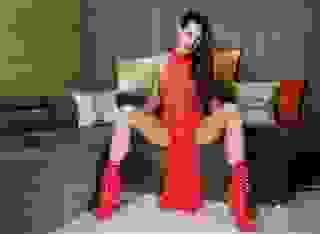- How To
- Building Wonderland
Note: You can change font size, font face, and turn on dark mode by clicking the "A" icon tab in the Story Info Box.
You can temporarily switch back to a Classic Literotica® experience during our ongoing public Beta testing. Please consider leaving feedback on issues you experience or suggest improvements.
Click herePlease refer to the preface to Only Consenting Adults for a guide to all the connected storylines.
"When asked for a recommendation for a book on [X] for the generalist, I recommend Alice in Wonderland because it's the best book on anything for the generalist." - Unknown
Now that the work is finally completed, I have been asked about the process behind constructing the Wonderland universe of connected stories, questions that have given rise to this brief response. It isn't about the stories themselves, but about the basic mechanics of putting together a coherent storyline that has spanned a million words in 176 chapters, 11 books and various side-stories. I hope it gives a useful insight into one way of constructing a large, self-referential store universe. Is it the right way? All I can say is that it worked for me.
But first, a note on scale and the problems it brings.
A five thousand word 2-pager is a fairly easy thing to write by the seat of your pants (a pantser), even going up to twenty or thirty thousand words. At all times, you are able to see the end from the beginning, or still recall the beginning from the end. A change in a plot point can ripple through the text with some amount of rewriting; a character's background or motivations can be tweaked as required in a fluid self-feedback loop.
A novel-length work (anything upwards of fifty thousand words) can be written in the same way, but with the larger scale come benefits from structure, plotting, character notes, (a plotter) because rework becomes much more arduous and editing more fraught. A glaring plot hole in five thousand words is a lot harder to miss and a lot easier to patch during a re-read than in fifty thousand words. On top of this, as a writer it often requires there to be a narrative framework and pathway to get the story to the end, a set of guard rails to motivate and inspire the effort. Meandering after forty thousand words can often be the death of a story before it's even completed.
Passing five hundred thousand words forces a change again. It's no longer possible to hold all elements together in one place, and while the end may be known as well as the start, the path between them is not. There is an element of meta-pantsing, where the stories are laid out and structured, but how they interact with each other is not, or whether it will turn out that they are even required in the first place once the last sentence is written. There is an overall narrative architecture and a degree of blind faith that the hundred thousand words of a particular character's storyline is going to be able to fit when everything comes to be assembled together perhaps years down the line. Despite the urge to control all the variables, it becomes impossible at a certain scale and instead, adaptability becomes the most important thing. The characters and the stories take on a life of their own and there is an element of blind trust that they're going in the direction you want them to go, without having to commit the sin of Deus ex Machina to jump them back onto the rails.
"No battle plan survives contact with the enemy." - Field Marshall Helmuth von Moltke
Before the best laid plans are set out, there needs to be something that seeds the story, a spark of an idea that just won't go away. How do you go from those bright fragments into a coherent narrative? How did the Wonderland storylines come about? Let's dive into those origination points, the verbal orogeny (or as it felt sometimes, the teratogeny), as an illustration of that creative process.
Before we start, a warning: if you haven't read the Wonderland series of stories, the below text will contain spoilers: proceed at your own risk. This is also a formal notice that Wonderland is considered by me to be an open forum for other authors if they wish to explore and take characters on new journeys, within the bounds of fair use, substantive accreditation and acknowledgement that copyright rests with myself.
The Wonderland series started by accident, with a rough idea about a man going into a woman's hotel room on the morning of her wedding. Within a few sentences, they knew each other intimately, within a few more their relationship was founded, coming out organically from their conversation. The words brought up more questions: it turned out that she wasn't marrying him, she was marrying someone else. Then, the pathos of his bittersweet feelings as he accepted it, opening up the question as to who she was marrying instead and why he wanted her to be happy. By the conclusion of the piece, Jen was taking Anya as her wife while Henry doomed himself to the unofficial party in their relationship, an attempt by the three lovers to legitimise their unconventional union when the laws didn't permit or recognise the true nature of the relationship between them all. In all, it took a couple of thousand words to condense a whimsy into something more substantial. The driving factor, I believe, in story generation is curiosity, the willingness to explore the reasons behind the thing that was shown.
So, multiplying now, there were more questions to be answered. Why didn't Jen's parents turn up to the wedding of their only child to another woman? Was Henry a pushover, letting himself be set aside by the two women or was he making the sacrifice because he was the most appropriate of the three of them to bear it? Why was Jen's father actively campaigning for traditional marriage if his own daughter was going to be one of the most disadvantaged?
It was a puzzle that required an answer. Why would you make your own child unhappy just to uphold your own viewpoint? It turned out that the answer wasn't found at the wedding as originally planned, or in the reception party afterwards. It could have been trotted out in a couple of paragraphs of drunken character exposition between the first course and the groom's speech and none of Wonderland would have happened, but for an unexpected arrival. Moran turned up in the story and took over; Anya's proud father provided the perfect counterpoint for Jen's absent parents, and suddenly the chance to tie it all up neatly inside twenty thousand words slipped away.
From a loose idea, a structure began to construct itself, a seat-of-the-pants story crystalising slowly into something much bigger, a seed around which other ideas were able to coalesce, and the nature of the undertaking began to change. It turned out that the answer to the puzzle wasn't found in The Monogamists at all. It had to wait until the end of Only Consenting Adults, a million words later, over a hundred characters later, with the revelation of a bitter betrayal, a dark secret and an unshakeable enmity dating back decades that gave rise to a devastating plot for revenge.
The books were not plotted out linearly, each twist and turn mapped in exquisite detail on a whiteboard with coloured lines and side notes, despite the fanciful portrayal in Critical Response. Instead, there was a space within which a series of ideas floated, snippets of scenes that sparked off further investigation. Henry and Jen in her hotel room on the day of her wedding was the first one; how would the other elements weave their way into the landscape that was beginning to form?
It began with that single thread: from the opening scene in the hotel room on Jen's wedding day to the grand revelation by Jen's mother in the sitting room of Jen's childhood home ten books and story-years later. There were other items that also required consideration. Each brief moment, like Jen's confession that her parents weren't coming to the wedding, added its own thread and began to entangle itself with that first strand.
The next spark of an idea was a scene set in a strip club, which was later written as the stage in the Lost and Found, with a housewife standing in front of an audience of men, slowly undressing for them. The curious thing was not how the men behaved, but her own reaction. She wasn't anxious or ashamed, two emotions that might be expected of a woman baring everything for the first time in front of strangers. Instead, she felt the rush of controlling the room by exhibiting herself, standing nude as a testament to her own empowerment, the final rejection of the role of dutiful wife and homemaker that she had been pigeonholed into.
Only when Jen was pursued by Damian at the charity ball, forcing Henry to step in, did the nude woman get a name: Cassidy Hayes, the wife of Damian, the mother of his two children, the target of Lily's domineering behaviour and ultimately the one person in all of Wonderland who held their ground while everyone else fell apart. It seemed entirely appropriate that one of the heroes of the saga would be an unremarkable suburban housewife transforming herself at last into something entirely breathtaking and unstoppable.
Another spark was a scene with two women talking in a coffee shop. A man joins them. One of the women picks up her cup of coffee, takes a sip, and then empties the contents of it into the man's lap, forcing him to sit there, scalded. That Quinn would go from that hapless, middle-aged, unremarkable lawyer to a central character in the space of three books was unexpected. That the woman watching it all happen would be Cassie, and that the inflictor of such pain would be Syn was also unexpected.
What was more unexpected was that, as Quinn is allowed to go and clean himself up, it becomes obvious that Syn did it out of a deep affection for the man she had inflicted the pain on, for the most extraordinary and touching of reasons. Why was he in the coffee shop in the first place? An envelope appeared abruptly on the table, sealed for a year. Who had sealed the envelope? What was inside? Why had it been given into Syn's safekeeping and why was she being so cruel? Other threads began to emerge, binding themselves around the core.
The next spark, of a man in a cage watching his wife being led off to a bedroom by a stranger, provoked more questions that needed to be answered, building out from that ending scene, which became Alena's End, into a sequence of events that explained her actions and the unbreakable love that bound together and then the tragedy that tore Quinn and his wife apart.
The next spark was the hardest: a woman with a little purple velvet bag and two shiny golden marbles and the look of hope and sadness on her face as she showed her husband. Rosa and Aidan's story to arrive at that moment, and the catastrophic effects on their marriage of that first marble being lost, formed a central thread. It spanned the journey of a young, vibrant married couple with the entire world at their feet, into the trials of infertility, the games they played to bear the unbearable, and then the final infidelity. The second embryo, that precious final golden marble, came to hang over the entire Wonderland storyline, haunting the paths they took and shaping everything they did, descending into a place of anguish.
The second marble was another fundamental question. If Rosa was unable to bear children, then how could that be resolved? Someone would need to bear it on her behalf, but who? Indi became the answer to that question, but prompting questions of her own. Where did this waif drift in from? How was she found? That particular thread curled through a number of story fragments that had always been off to one side, ignored. Now, there seemed to be a path through, linking them together and binding Andrew and Jodie and Syn and her dead husband Harvey, and then Alice and James and ultimately the story of Chloe in the coffee shop siege and Hayden, her tormentor.
These threads twined together, and then connected in an entirely unexpected way with Gerard, Jen's father, proving at last an explanation for his reluctance to embrace his daughter's life. Fleshing out the theme of blackmail, power plays, people who would stop at nothing to get what they wanted, the threads bound tightly together, forming the rope that would run through all the stories and bring them all together in the conclusion.
But there was just one more fragment, a tiny thing but the most poignant question that was asked. A tall, gangly man standing at the railing of a rooftop bar waited for the woman who he had betrayed. Why had he betrayed her? What suffering had he caused her? How could he ever hope for her forgiveness? Adam was looking for redemption from the only person who could give him that: Eve. It turned out that these two characters, orbiting ever more tightly around each other through all of the stories, were different to Tom and Hayley, or Alice and James or Cameron and Mina. They weren't there to provide supplemental context, drifting along in tangential plotlines of their own.
These two were jumping in and out of the threads, bit players seemingly in search of a role, but in the end the key to everything. When Adam leaves the Council of Alices, he already knows what he has to do, and the terrible price he will pay. That Eve unexpectedly becomes part of that price when he walks into the Silent Room doesn't stop him, and his awful choice between two unspeakable evils is the key to unlocking everything.
"Train hard fight easy." - Alexander Suvorov
The process of writing the Wonderland universe was important, putting aside some time on a regular basis to keep up momentum, until the work that was hard to do at the beginning became muscle memory by the end. This is evident in the later books, where the stories evolve as much as the characters do, leaving behind the basic mechanics to explore deeper concepts. It became as much about discipline, about writing even just a little but often, as it did about the story to be told. As an inspirational poster once told me: inspiration without execution is hallucination.
But what about the actual mechanics of it, about bashing out a couple of thousand words at a time in free moments for a couple of years? As discussed, Wonderland grew from a question that generated further questions. It was also seeded by glimpses of standalone vignettes that required an explanation, working towards each other as the stories grew and took form. The process of putting it all into words was non-linear, expanding outwards from each of these seeding points until eventually, like an organic thing, two would touch and spark off a flurry of further growth elsewhere, forming a ragged patchwork that just barely held itself together, something that could be executed at last.
The trick, if ever there was such a thing, was to work a feasible path toward the high points of the journey, bringing the story along and building up to those moments where there is the grand reveal, where for just a moment everything stops and the only sound is of the metaphorical microphone hitting the floor. When Alice trails the Queen of Hearts on her leash into the club, a transformation completes that was two books in coming. When Aidan looks up into the starry night in Cassie's back garden and asks for direction from the god of second chances, the pendulum begins to swing back in an arc that started in Oxygen Games. There needs to be a current pulling the reader towards these turning points, then a moment to pause for reflection, and then a clear path away to the next. There is a necessary cadence, with action and quiet interstitials, high points and then low blows.
From this high-level architecture, there was then the hard work of filling in the spaces, keeping continuity flowing, doing the legwork of setting up the background, getting into the nooks and crannies. Wonderland wasn't written sequentially; that would have been too daunting. Instead, it was written fractally from the superstructural level inwards, each level then unfolding into another level within, and then down and down to the limit of resolution, until the Hilbert curve had filled all required space.
The approach meant that the end was always visible from the start, that there was always the light on the hill to head towards, and that if filling in one space became arduous, there were other spaces to work on. It also required surprisingly little reworking, having to do minor tweaking to individual threads rather than wholesale continuity shifts. It also permitted some frolicking, crossing over between stories: having Jen and Anya and Henry sit with baby Millie in the café in the park while Hayley is waiting on tables, serving English Breakfast tea to Hayden while he offers to make Chloe disappear, each unknown to the other.
Are all the backgrounds explored? Are all questions answered? No.
Are they ever going to be?
That's a hard question to answer, and maybe it's not my question to answer. I like the idea of dangling threads, of the possibilities, the inspiration they may engender in others to take up the fluttering, ragged ends and tug them a little further. Insofar as one of the aims of Wonderland was to encourage new authors to pen their first stories, taking that foolish, courageous, amazing first step, this has already yielded wonderful results.
But, after all the time and effort that went into all of this, it's finally time to move on. There are other sparks, new characters waiting in the wings, new stories.
Who are they? What do they want? Where are they going?
Who knows? Tomorrow's question.
As to the why of all this, is there a point? There is a central thesis to Wonderland: that while we are all different, we are also the same, that our strength doesn't come from our homogeneity but rather from our diversity. That tolerance of differences is the key because the path towards the future is the path least travelled.
Beyond this, Wonderland is an adventure into the secret worlds that exist behind the curtain. It details experiences that are not our own. It is concerned with the things that we say in the dark.
Maybe that's the point. Maybe that's reason enough.
---
Follow me for updates to my other stories. If you like what you read, please leave a comment or a star rating. Constructive feedback is always welcome. If you want further adventures, or to check out my other stories, my story page is here
- COMMENTS
I’m writing the full version of my 750 word ‘It wasn’t COVID’ story. I’m not as organized as you are, but it’s looking to be a million word story (not sure it if will really be a million, but it’s big). I’m enjoying letting the story take on a life of its own. I’m writing mostly on my iPad and rely heavily on Apple Notes to keep track of characters, places, things, milestones, the timeline, URL’s for bits of information I can use to add a touch of realism, etc. Plus, I can hyperlink between note cards for things that are related. It sync’s to iCloud so I have access to the notes on every one of my Apple devices.
.
I’m writing in Google Docs sync’ing to Google Drive so I can change devices for writing and always have access to my originals. I suppose I could use Google Keep for notes, but the Apple version is better integrated.
.
Periodically, I read my story from the beginning to make sure it still makes sense and to make sure there’s a believable line of ‘how I got here’.
One thing’s for certain: my brain really loves writing this monstrosity. Building my alternate reality is lots of fun and I don’t get tired of rereading it from the beginning.
.
Then there’s {colorful metaphor}{colorful metaphor} people like you who plant things in my brain like “that’s a great idea!”. :-)
.
Thanks for the essay.
Thanks for sharing that... it's really fun to see the organic way plots inspired plots and forced interactions which became this epic journey. The CR vision -- storylines, character masters, colored interaction lines -- it comes together as if that were the genesis, but noting is ever that straightforward.
Love your comment about the transition from every word being an effort at the beginning to it flowing like muscle memory at the end... that's an amazing encouragement.
Looking forward to your next epic!
Everyone's got a plan until they get punched in the face! I had to stop reading this halfway through, once the spoilers seemed to be reaching beyond where I've traveled. I'd better saddle up and hit the road!
You know, I definitely would have bought you a [insert beverage of choice] to just sit down with you for an hour or more to talk shop and pick over just how you put all this together, but in the absence of such I guess this essay will have to do.
Although the drink offer probably stands if the opportunity ever comes up.








